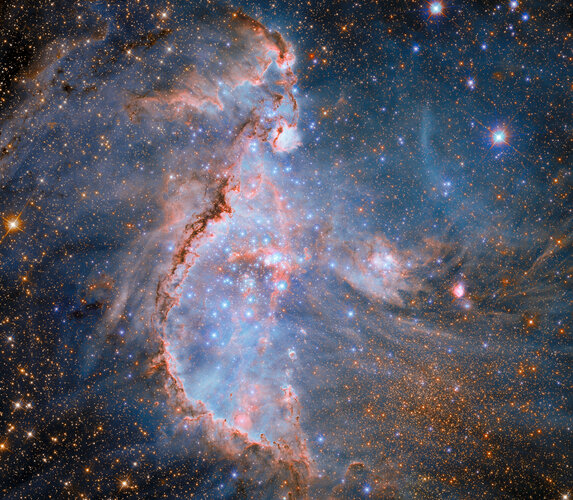
Copernical Team
Rising odds asteroid that briefly threatened Earth will hit Moon
 An huge asteroid that was briefly feared to strike Earth now has a nearly four percent chance of smashing into the Moon, according to new data from the James Webb Space Telescope.
The asteroid, thought to be capable of levelling a city, set a new record in February for having the highest chance - 3.1 percent - of hitting our home planet than scientists have ever measured.
Earth's plan
An huge asteroid that was briefly feared to strike Earth now has a nearly four percent chance of smashing into the Moon, according to new data from the James Webb Space Telescope.
The asteroid, thought to be capable of levelling a city, set a new record in February for having the highest chance - 3.1 percent - of hitting our home planet than scientists have ever measured.
Earth's plan Earth from Space: The shrinking Aral Sea
 Image:
The Copernicus Sentinel-2 mission shows us what is left of the Aral Sea, once the fourth largest lake in the world.
Image:
The Copernicus Sentinel-2 mission shows us what is left of the Aral Sea, once the fourth largest lake in the world. Hubble spots stellar sculptors at work in a nearby galaxy
 Image:
Image:
This new image from the NASA/ESA Hubble Space Telescope showcases NGC 346, a dazzling young star cluster in the Small Magellanic Cloud. The Small Magellanic Cloud is a satellite galaxy of the Milky Way, located 210 000 light-years away in the constellation Tucana. The Small Magellanic Cloud is less rich in elements heavier than helium — what astronomers call metals — than the Milky Way. This makes conditions in the galaxy similar to what existed in the early Universe.
Although several images of NGC 346 have been released previously, this view includes new data and is the first to combine
A chance alignment in Lupus
 Image:
A chance alignment in Lupus
Image:
A chance alignment in Lupus Earth Observation Excellence Award 2025 winners

In recognition of outstanding contributions to scientific advancement and innovation using Earth observation data, the ESA Earth Observation Excellence Award is presented annually to early-career researchers.
Firing up HENON’s engine
 Image:
Firing up HENON’s engine
Image:
Firing up HENON’s engine Scientists fuse two extreme quantum materials into one exotic platform
 An international research collaboration led by Rutgers University-New Brunswick has succeeded in integrating two highly unconventional quantum materials into a synthetic structure long considered unattainable, paving the way for advances in quantum computing and materials science.
Featured on the cover of Nano Letters, the breakthrough emerged after four years of rigorous experimentation,
An international research collaboration led by Rutgers University-New Brunswick has succeeded in integrating two highly unconventional quantum materials into a synthetic structure long considered unattainable, paving the way for advances in quantum computing and materials science.
Featured on the cover of Nano Letters, the breakthrough emerged after four years of rigorous experimentation, How VIN Decoding Became the Silent Ally of Smart Used Car Buyers
 The used car market was once a jungle. Buyers wandered it blindfolded - guessing, trusting, hoping. They sniffed tires, tapped hoods, and squinted at dashboards. Still, they walked away with lemons. Sometimes polished. Sometimes cursed.
But not anymore.
Now, the most powerful ally doesn't stand on the lot. It lives in code. Silent. Systematic. Brutally honest. It's called the Vehicle
The used car market was once a jungle. Buyers wandered it blindfolded - guessing, trusting, hoping. They sniffed tires, tapped hoods, and squinted at dashboards. Still, they walked away with lemons. Sometimes polished. Sometimes cursed.
But not anymore.
Now, the most powerful ally doesn't stand on the lot. It lives in code. Silent. Systematic. Brutally honest. It's called the Vehicle James Webb captures earliest hint of cosmic clarity
 From a fiery origin to its slow expansion and eventual formation of structure, the Universe's evolution has long fascinated scientists. A key chapter in this story unfolded a few hundred million years after the Big Bang, when the earliest galaxies and stars began coalescing from vast reservoirs of primordial gas. Astronomers have detected galaxies dating back to less than 300 million years post-
From a fiery origin to its slow expansion and eventual formation of structure, the Universe's evolution has long fascinated scientists. A key chapter in this story unfolded a few hundred million years after the Big Bang, when the earliest galaxies and stars began coalescing from vast reservoirs of primordial gas. Astronomers have detected galaxies dating back to less than 300 million years post- The ticking frontier of thorium powered nuclear clocks
 In a recent perspective featured in the National Science Review, Dr Xin Tong from the Innovation Academy for Precision Measurement Science and Technology, Chinese Academy of Sciences, outlines the transformative potential and enduring technical hurdles of thorium-229-based nuclear optical clocks.
Time and frequency currently stand as the most precisely measurable physical parameters, wit
In a recent perspective featured in the National Science Review, Dr Xin Tong from the Innovation Academy for Precision Measurement Science and Technology, Chinese Academy of Sciences, outlines the transformative potential and enduring technical hurdles of thorium-229-based nuclear optical clocks.
Time and frequency currently stand as the most precisely measurable physical parameters, wit 
































